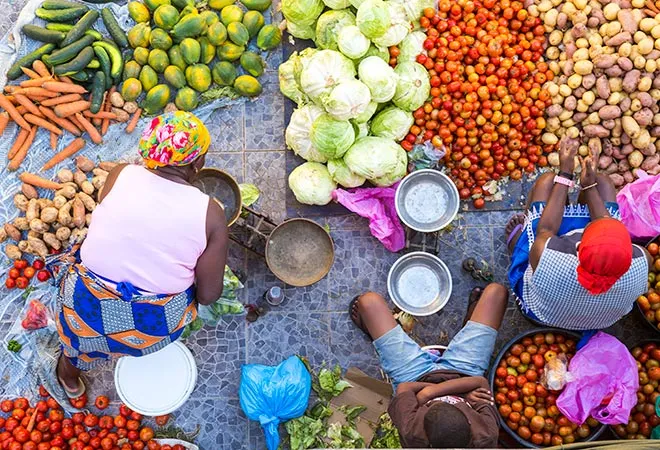
“The state of the continent is good,” writes Dr. Akinwumi A. Adesina, President of the African Development Bank Group, in the foreword to the African Economic Outlook 2019. Most of the African countries witnessed an economic turnaround in the 2000s. Between 2000 and 2010, Africa’s average growth rate was 5.3%, much higher than the average growth rate of 2.6% in the previous decade. Twelve African countries experienced an average growth rate above the growth rate of 6.1%, and two countries namely Angola and Equatorial Guinea had double digit growth rates. Africa’s GDP growth rate in 2018 was 3.5% in 2018 and the African Economic Outlook 2019 projects that the continent’s economic growth will accelerate further to 4% and 4.1% in 2019 and 2020 respectively. East Africa is the fastest growing region in Africa with a growth rate of 5.9%; the region is expected to grow at an even higher rate of 6.1% in 2020.
READ: Can Africa and India meet the SDG 2030 target of Zero Hunger?
A remarkable improvement in Africa’s economic performance since the turn of the millennium led to a dramatic change in the image of the continent. Africa was no more the ‘Hopeless Continent’ it once was and it became a leading destination for foreign direct investments. However, high growth did not lead to a substantial decline in hunger. In fact, the opposite is true. Hunger has increased in almost all the regions of Africa except Eastern Africa in 2017 (see table). However, several countries in East Africa such as Ethiopia and Djibouti are currently facing severe food insecurity because of a protracted drought. The 2019 long rains have been well below average and most households in the regions have not recovered from the 2016-17 drought.
Conflict has pushed South Sudan into the world’s worst food crisis. Half of the country’s population or about 7.1 million people are suffering from extreme hunger.
Table: Prevalence of undernourishment (%) in Africa, 2005-17
|
2005 |
2010 |
2012 |
2014 |
2016 |
2017 |
| Northern Africa |
6.2 |
5.0 |
8.3 |
8.1 |
8.5 |
8.5 |
| Sub-Saharan Africa |
24.3 |
21.7 |
21.0 |
20.7 |
22.3 |
23.2 |
| Eastern Africa |
34.3 |
31.3 |
30.9 |
30.2 |
31.6 |
31.4 |
| Central Africa |
32.4 |
27.8 |
26.0 |
24.2 |
25.7 |
26.1 |
| Southern Africa |
6.5 |
7.1 |
6.9 |
7.4 |
8.2 |
8.4 |
| Western Africa |
12.3 |
10.4 |
10.4 |
10.7 |
12.8 |
15.1 |
| Africa |
21.2 |
19.1 |
18.6 |
18.3 |
19.7 |
20.4 |
Source: Food and Agriculture Organisation (2018)
The rise in hunger was also accompanied by a re-emergence of famines. In 2017, famine was declared in South Sudan and Somalia and north-eastern Nigeria were on the brink of a famine. Conflict has pushed South Sudan into the world’s worst food crisis. Half of the country’s population or about 7.1 million people are suffering from extreme hunger. Similarly, protracted conflict and severe drought have led to a sharp increase in the acute malnutrition rates and nearly 2.2 million people are suffering from severe hunger. The food security situation remains volatile in north-eastern Nigeria. About 2.7 million women and children in Adamawa, Yobe, and Borno states need nutrition support and about 310,000 children and 250,000 children suffer from severe acute malnutrition and moderate acute malnutrition respectively.
Protracted conflict and severe drought have led to a sharp increase in the acute malnutrition rates and nearly 2.2 million people are suffering from severe hunger.
Thus, the state of food security and nutrition in Africa is far from good. High GDP growth rate of the continent masks the underlying vulnerabilities of the African people. The answer to the puzzle of high growth and higher rates of hunger lies in the nature of Africa’s growth itself which has not been led by any improvement in agriculture, the sector which continues to employ the bulk of the population. Agricultural productivity in Africa is extremely low and the continent is heavily dependent on food imports. Cereal yield in Africa is just 1,394.7 kg per hectare, less than half the world average of 3,966.8 kg per hectare and much lower than Euro Area (5,362.6 kgs per hectare), North America (7,318.4 kgs per hectare), and East Asia and Pacific (5,401.4 kg per hectare). Currently Africa spends about USD 35 billion annually on food imports. If current trends continue, the continent’s food import bill will increase to USD 110 billion by 2025.
It is also important to note that more than half of the global population growth between now and 2050 will occur in Africa. A growing population in the context of climate change will make Africa more food insecure in the future. According to most studies, climate change is already a reality in Africa. The severe drought in 2015-16 in East and Southern Africa which has put millions in need of food aid is the result of a strong El-Nino effect. In the coming years, reduced precipitation and increased evapotranspiration due to climate change will increase the frequency of droughts in Africa. Given that Africa’s cereal yields are the lowest in the world and most of the production is rain-fed, agricultural production will be adversely affected.
More than half of the global population growth between now and 2050 will occur in Africa. A growing population in the context of climate change will make Africa more food insecure in the future.
In a nutshell, hunger continues to be the greatest development challenge for Africa. Higher growth and higher export earnings based on exports of natural resources will not help Africa achieve the zero-hunger goal. Instead, the continent needs a massive strategy to harness its cultivable land and water resources to dramatically increase its food production in order to eliminate hunger, reduce its import bill, and meet the challenges that climate change poses before it.
WHO supports one million malnourished children in north-east Nigeria
The views expressed above belong to the author(s). ORF research and analyses now available on Telegram! Click here to access our curated content — blogs, longforms and interviews.




 PREV
PREV


